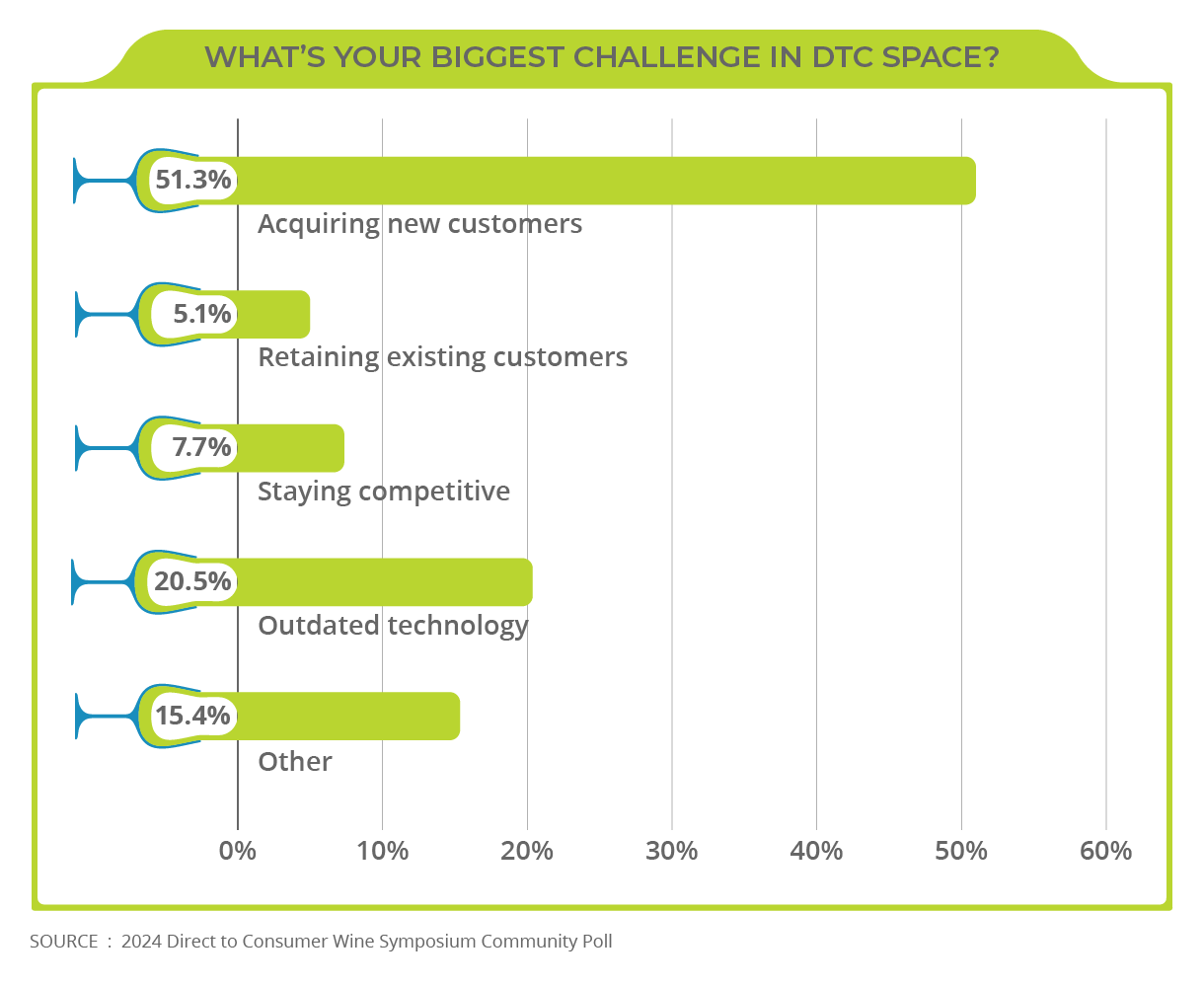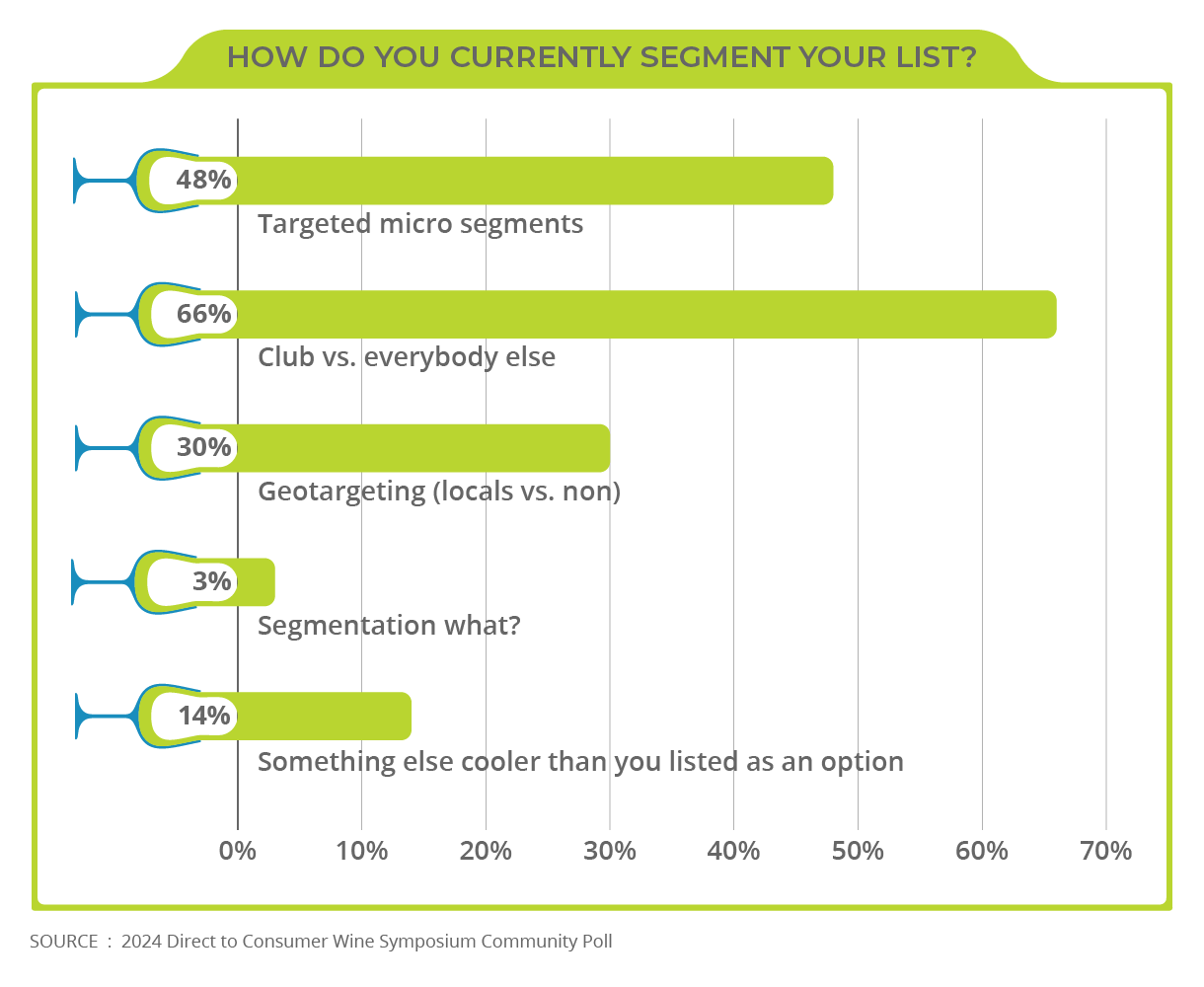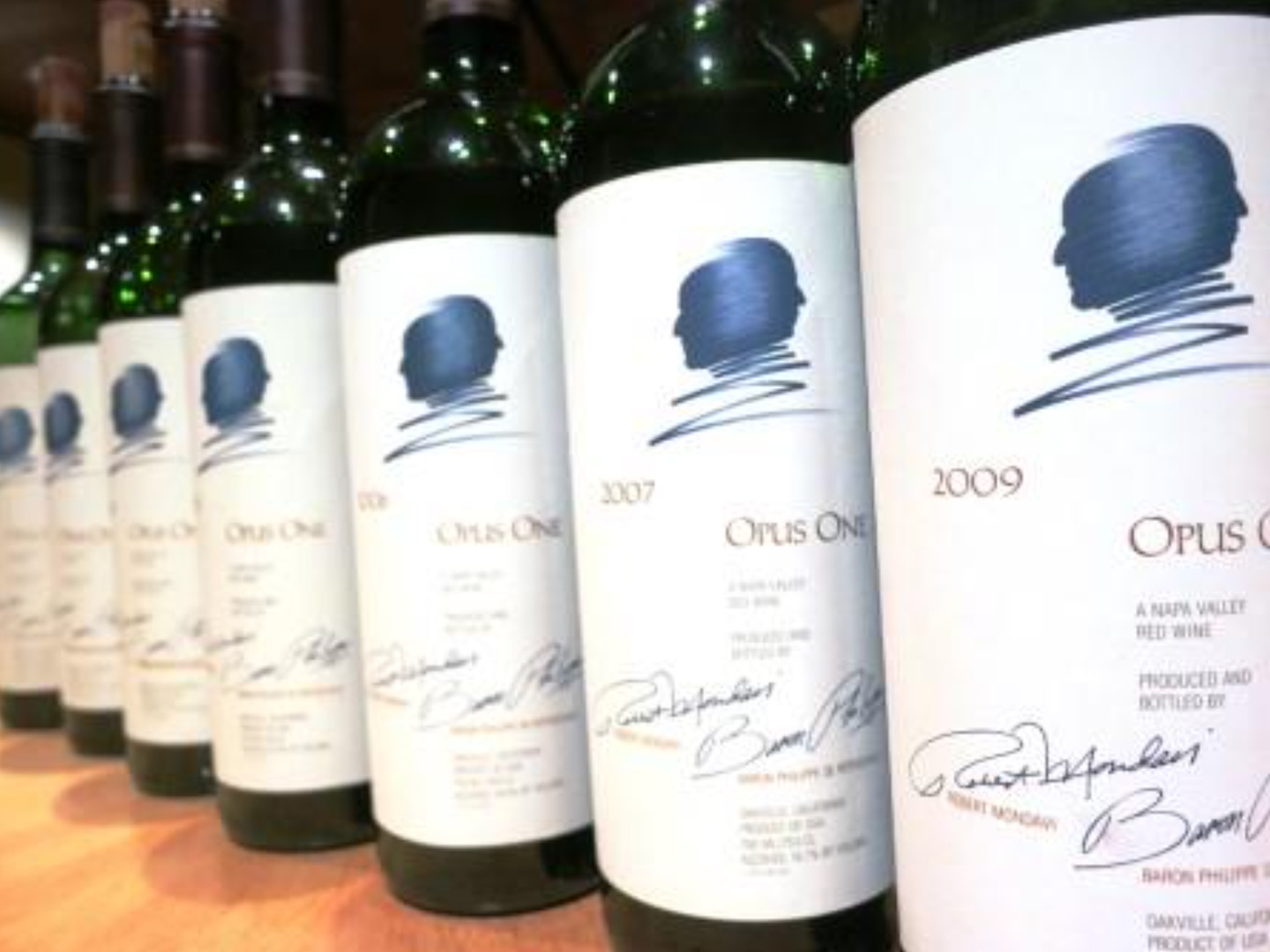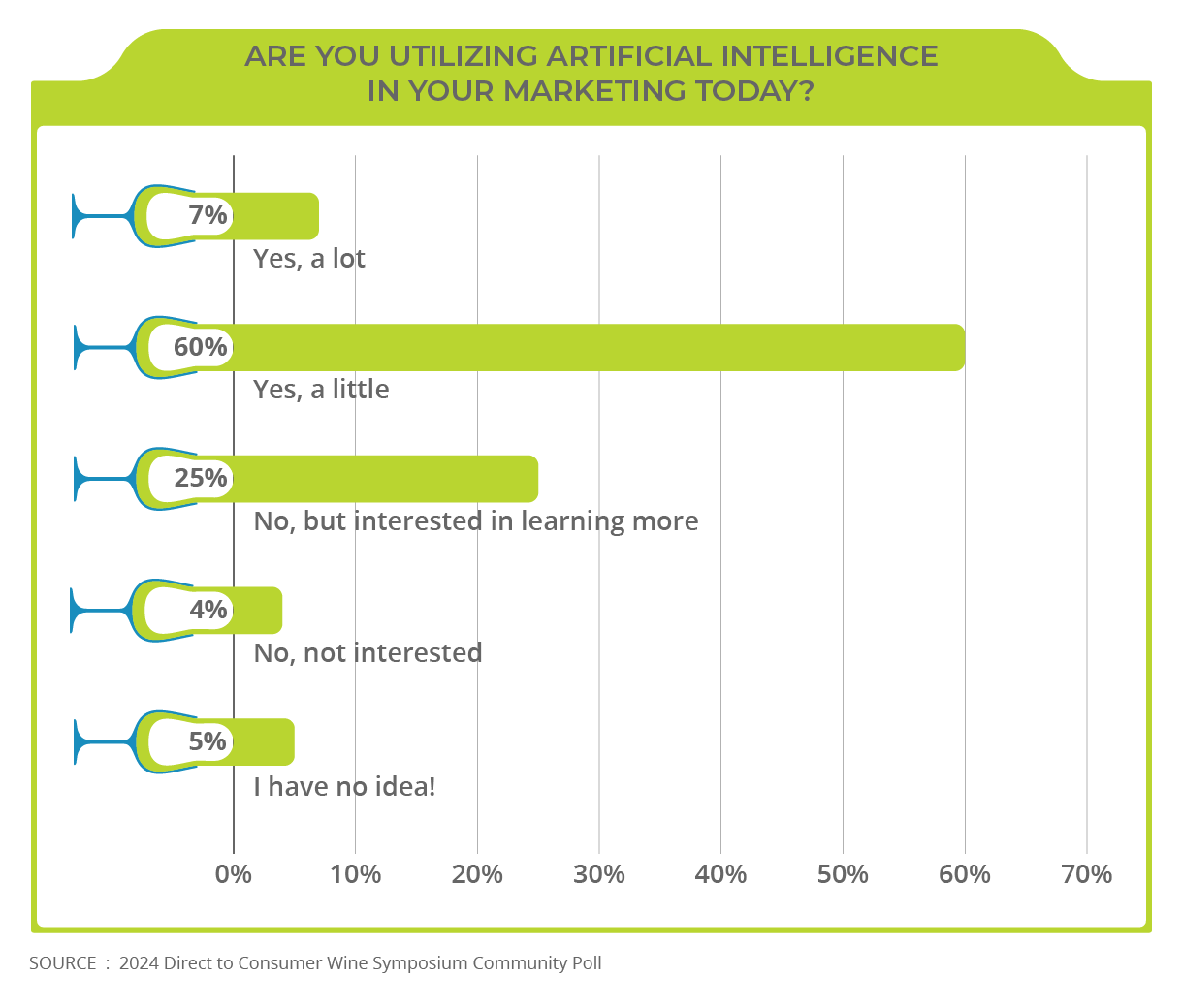
2024 YTD Conference Themes
It’s All About Acquisition & Data
We’re about halfway through the annual winter flurry of conferences that dot the calendar from January – April each year. This year we’ve noticed two trends. First, every conference seems to have at least one session on the importance of understanding your customer. If there is anything we’ve learned since COVID is that customers are precious and treating them with deliberate consideration with the goal of fostering a genuine connection with your audience not only helps you with the immediate sale at hand but saves you time and money on future sales.
Then how do you explain the second noticeable theme this year which is the continual chorus of wineries looking to acquire customers? How are these two seemingly unrelated threads tied together? The answer lies in the insight that to find the right consumers externally, you need to be aware of who your best customers are internally.
Here are five key tips and best practices to help you create and foster a genuine connection with your audience to evolve your omni channel marketing approach.

1. Audience Understanding and Segmentation:
Obviously, you need to begin by thoroughly understanding your audience across all channels. And this isn’t anecdotal of what you see, or you think you know – use data analytics and market research to segment your audience based on demographics, behaviors, and preferences. This enables you to tailor your messaging and content to resonate with different audience segments effectively.
Understanding your audience is paramount in developing successful marketing strategies. Several tools can aid in this endeavor, such as Google Analytics, which provides valuable insights into website traffic, demographics, and user behavior. Social media analytics platforms like Sprout Social or Hootsuite offer detailed metrics on audience engagement, demographics, and sentiment analysis across various social media channels. Customer relationship management (CRM) software such as Salesforce or HubSpot enables businesses to track customer interactions, preferences, and purchase history, facilitating targeted marketing efforts. Additionally, conducting surveys, focus groups, and interviews can provide qualitative insights into audience preferences, pain points, and motivations.
In the wine industry, segmentation plays a crucial role in catering to diverse consumer preferences and behaviors. The most basic segmentation approach is demographic segmentation, which divides consumers based on factors such as age, gender, income, and education level. For example, a winery may target affluent consumers aged 35-54 with premium wine offerings, while also appealing to younger demographics with more affordable and approachable varietals. If you can take it a step further, psychographic segmentation considers consumers’ lifestyles, values, and personality traits. For instance wine enthusiasts who prioritize sustainability and organic production methods may be targeted with eco-friendly wine options. Finally, behavioral segmentation focuses on purchase behavior, such as frequency of wine purchases, preferred varietals, and occasions for consumption. If you track this, wineries can tailor marketing campaigns to different segments, such as occasional buyers seeking gift options versus regular buyers interested in wine club memberships. By leveraging segmentation strategies, wineries can effectively engage with their diverse audience and enhance customer satisfaction and loyalty.

2. Consistent Brand Voice and Messaging:
Most know to maintain a consistent brand voice and messaging across all channels to build trust and familiarity with your audience. Whether it’s your website, social media, email marketing, or offline channels, ensure that your brand’s tone, values, and messaging remain cohesive and aligned with your audience’s expectations.
Maintaining a consistent brand voice and messaging is crucial for building brand identity, fostering trust, and enhancing brand recall among consumers. Recent studies have highlighted the significance of brand consistency across various channels and touchpoints. According to a study by Lucidpress, consistent branding across all platforms can increase revenue by up to 23%. Moreover, a report by McKinsey & Company found that companies with consistent branding are 20% more successful than those with inconsistent branding. These findings underscore the importance of maintaining a unified brand voice and messaging strategy to resonate with consumers and drive business growth.

In the wine industry, consistent brand voice and messaging are instrumental in establishing a strong brand presence and connecting with consumers with a ubiquitous product like wine. Wineries often emphasize unique aspects of their brand, such as heritage, terroir, or winemaking philosophy, to differentiate themselves in a competitive market. For instance, a family-owned winery may emphasize its generational expertise and commitment to traditional winemaking practices, conveying a sense of authenticity and craftsmanship. Consistent messaging across packaging, marketing materials, and digital platforms reinforces the brand’s identity and values, making it easier for consumers to recognize and engage with the brand. Wineries like Napa Valley’s Opus One or Bordeaux’s Château Margaux exemplify this approach by consistently communicating their brand’s prestige, quality, and exclusivity through their marketing efforts. These iconic brands haven’t changed their logo, messaging, or label since inception (in Margaux’s case over a century). By maintaining a consistent brand voice and messaging, wineries can effectively convey their brand story and values, resonating with consumers and building long-lasting relationships.
3. Personalization at Scale:
So what do you do with all this knowledge? You leverage data-driven insights to personalize the customer experience across all touchpoints. That’s a fancy way of saying you provide individual and exceptional customer experience. This is becoming easier as wineries utilize automation and AI technologies to deliver personalized content, recommendations, and offers to individual customers based on their preferences, past interactions, and behavior. This personal touch enhances engagement and fosters a deeper connection with your audience. And judging by the interest in AI and automation topics at this year’s conferences, we’re noticing that quite a few wineries are already on this wavelength.

Personalization at scale is a key strategy for enhancing customer engagement and loyalty in the wine industry. Small wineries can leverage automation and AI technologies to deliver personalized content and recommendations to their customers. Email marketing platforms like Mailchimp or Constant Contact offer user-friendly automation features that allow wineries to send personalized email campaigns based on customer preferences, purchase history, and behavior. By segmenting their email lists and tailoring content accordingly, wineries can deliver targeted promotions, event invitations, and educational content to different customer segments, fostering a deeper connection with their audience.
Furthermore, customer relationship management (CRM) software such as HubSpot or Zoho CRM enables wineries to centralize customer data and automate personalized interactions across multiple channels. These platforms provide insights into customer interactions, preferences, and engagement levels, allowing wineries to create personalized experiences at scale. For example, wineries can use CRM data to send personalized recommendations based on past purchases, offer exclusive discounts to loyal customers, or follow up with customers after a tasting room visit. By leveraging automation and AI technologies, small wineries can enhance the customer experience, drive sales, and strengthen brand loyalty in a competitive market.
4. Interactive and Engaging Content:
In order to create individual experience for all these customers you quickly realize you must generate interactive and engaging content that encourages active participation from your audience. Incorporating multimedia elements such as videos, questions, polls, and interactive tools make it easier to capture attention and drive engagement across different channels. These encourage feedback, comments, and user-generated content to foster a sense of community and belonging.
Interactive and engaging content is essential for capturing and retaining consumers’ attention in the competitive wine industry. Research studies have consistently shown the effectiveness of multimedia elements in engaging consumers. According to a study by HubSpot, incorporating videos in marketing emails can increase click-through rates by up to 300%. Similarly, research by Wyzowl indicates that 84% of consumers have been convinced to make a purchase after watching a brand’s video. Furthermore, interactive elements such as quizzes, polls, and contests have been shown to boost engagement and encourage audience participation. A study by Content Marketing Institute found that 81% of marketers agree that interactive content is more effective at grabbing attention than static content.
In the wine industry, wineries should aim for certain benchmarks to gauge the effectiveness of their interactive and engaging content. Metrics such as engagement rate, click-through rate, and time spent on page can provide valuable insights into consumer interaction with multimedia content. For instance, wineries can track the number of views, shares, and comments on videos posted on social media platforms or their website. Additionally, monitoring conversion rates for interactive content, such as sign-ups for events or newsletter subscriptions, can indicate its impact on driving customer actions. By setting and analyzing these benchmarks, wineries can optimize their content strategy to create more compelling and resonant experiences for their audience.
5. Omni-channel Integration and Seamless Experience:
The goal of all of this is to ensure seamless integration and consistency across all channels to provide a frictionless customer experience. Wineries need to implement omnichannel marketing strategies that allow customers to move seamlessly between online and offline channels while maintaining continuity in their journey. Whether it’s making a purchase, seeking customer support, or engaging with your brand’s content, ensure a seamless experience across all touchpoints.
Omni-channel integration and delivering a seamless experience are critical aspects of modern marketing strategies in the wine industry. Research studies consistently demonstrate the importance of integrated messaging across multiple channels. According to a study by Aberdeen Group, companies with strong omnichannel strategies retain an average of 89% of their customers, compared to 33% for companies with weak omnichannel engagement. Moreover, a report by Salesforce found that 76% of consumers expect consistent interactions across channels, highlighting the necessity for cohesive messaging and experiences. This underscores the significance of ensuring that brand messages are integrated seamlessly across all touchpoints, whether it’s through text, visuals, or overall brand identity.
In the wine industry, examples abound of the importance of consistent messaging and integration across various channels. Wineries that effectively integrate their online and offline presence can provide customers with a cohesive brand experience. For instance, a winery might maintain consistency in branding and messaging across its website, social media platforms, email communications, and physical tasting rooms. This could involve using consistent imagery, messaging, and tone across all channels, reinforcing the brand’s identity and values. Additionally, wineries that offer online purchasing options should ensure that the shopping experience aligns seamlessly with the in-person experience, maintaining consistency in product offerings, pricing, and customer service. By prioritizing omni-channel integration and delivering a seamless experience, wineries can enhance customer satisfaction, loyalty, and overall brand perception.
We still have several other conference to go but based on the agendas we’re assuming we’ll continue the above conversations. Understanding the substantial cost disparity between acquiring new customers and retaining existing ones underscores the imperative of prioritizing customer retention strategies. While expanding the customer base is vital for business growth, investing in nurturing and retaining loyal customers can yield substantial returns over time. By focusing on building lasting relationships and maximizing the value of existing customer bases, businesses can foster genuine connections with their audience and evolve their omnichannel marketing approach effectively.


